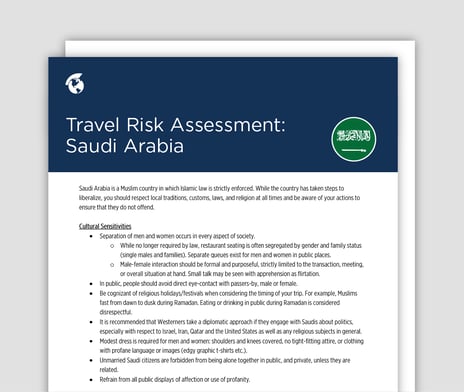As the global landscape evolves, organizations must prioritize the well-being of their travelers through strategic planning and continuous improvement. Travel risk assessments are part of the foundation of that effort.

| INSIDE THIS ARTICLE, YOU’LL FIND: What is travel risk? What are the components of a travel risk assessment? How to prepare an assessment |
Every great organization that sends personnel out into the world has an eye on safety and security. If the saying is “An ounce of preparation is worth a pound of cure,” then the real-life approach is to give your people all the information and tools they need — ahead of time — to have a safe trip. One of the best ways to do that is with a travel risk assessment.
A travel risk assessment, also called a pre-travel risk assessment, is typically a comprehensive document that includes relevant information and risk analysis for a person’s upcoming journey or travel destination. As part of their duty of care responsibilities, organizations should create effective travel risk assessments for their teams and people.
Creating a risk assessment is an excellent business practice. It allows travelers to focus on their work while armed with the knowledge of how to address a crisis. In a world where nearly half of business travelers say that health and safety are the biggest threats to their trips (according to a 2023 SAP Concur survey), giving them the resources to plan for risks can go a long way towards assuaging those concerns.
Serious trip planning requires more than a cursory web search before booking your ticket and jetting off, however. Good risk assessments are robust, iterative, and unique to each trip’s risks and concerns.
WHAT IS TRAVEL RISK?
First, it’s important to understand what it means to assess travel risk.
Travel risk refers to the potential threats and hazards that people face while on the road, especially in the context of work trips. It encompasses a wide range of factors that can impact their safety, security, and well-being.
There are obvious and extreme travel hazards that most people can name: the threats of terrorism, gun violence, or natural disasters, for example. But there are other types of travel hazards, both mundane and out-of-the-ordinary – everything from road closures and public transportation reroutes to civil unrest and rare endemic diseases.
Travel risk is also about probability or likelihood. Not every threat is the same in every location, and not every threat impacts each traveler in the same way.
TRAVEL RISK FOR DIFFERENT TRAVELERS AND LOCATIONS
A travel risk assessment is most effective when it is targeted to the location the person is traveling to, and details how likely it is that a threat will hinder or derail a trip.
The threats in Mexico are not the same as those in Saudi Arabia, and not all threats are equally likely to impact each person. For example, women travelers and LGBTQ+ travelers face different threats and different threat levels, and may need to approach these situations differently than their coworkers. Background and job history can also play a role when traveling to places like China.
In short, a travel risk assessment must be tailored to the individuals taking the trip and consider many factors that include the travelers themselves.
WHAT ARE THE COMPONENTS OF A TRAVEL RISK ASSESSMENT?
A thorough travel risk assessment considers health, security, safety, and transportation factors to identify and mitigate potential risks.
The following is a typical list of the components of a travel risk assessment, though your organization may choose to include additional components or focus more on certain factors.
1. HEALTH AND MEDICAL CONSIDERATIONS
Health and medical considerations can include:
- Vaccinations and health precautions: Assessing the need for vaccinations based on the destination. Providing information on necessary health precautions to prevent illnesses during the trip.
- Access to medical facilities: Evaluating the availability and accessibility of medical facilities at the destination. Ensuring travelers have information on nearby hospitals, clinics, and emergency services.
2. SECURITY AND SAFETY
Your team’s safety is paramount, but exactly what issues will you have to keep them informed of when they travel to a new location?
- Crime rates and safety concerns: Analyze local crime rates to gauge potential threats to travelers. Identify safety concerns in the area and recommend appropriate precautions.
- Local laws and regulations: Understand relevant local laws and regulations. Ensure travelers are informed about cultural norms and legal requirements.
- Natural disasters: Identify the likelihood of natural disasters such as earthquakes, hurricanes, or floods. Provide information on evacuation plans and relevant emergency shelters.
- Terrorism threats: Evaluate the risk of terrorism in the destination. Note how to monitor travel advisories and security alerts related to potential terrorist activities.
- Cybersecurity concerns: Consider the cybersecurity landscape, especially if the trip involves the use of electronic devices and sensitive information. Provide guidelines for secure online practices to mitigate cybersecurity risks.
- Civil unrest and political instability: Assess the political situation in the destination. Monitor for potential civil unrest or political instability and provide guidance accordingly.
3. TRANSPORTATION
Moving within a city or region can lead to complications, especially if unrest or poor infrastructure may lead to unexpected detours.
- Evaluation of transportation options: Assessing the reliability, safety, and suitability of available transportation modes. Considering factors such as public transportation, rental cars, or private transportation rather than Uber or Lyft.
- Road safety and transportation infrastructure: Evaluate the overall transportation infrastructure for its efficiency and potential risks.
4. RISK MITIGATION STRATEGIES
All the intelligence in the world won’t mean much if you don’t have a plan to address a hazard as it comes up. Risk mitigation strategies include:
- Emergency response plan: This plan should detail specific actions to be taken in various emergency scenarios, such as natural disasters, political unrest, or health crises. The plan will define roles and responsibilities for team members, communication channels, decision-making processes. For example, travelers should know exactly who to contact in case of an emergency that happens — whether outside of work hours or not — and know that their response provider will have the ability to support them in real-time.
- Evacuation procedures: Outline step-by-step evacuation procedures in case of serious threats or disasters, identifying primary and alternative evacuation routes. Designate assembly points and ensure all travelers are familiar with the evacuation plan.
- Emergency contacts: Compile a comprehensive list of emergency contacts, including local authorities, medical facilities, and organizational contacts. Ensure that all travelers have easy access to this list, both in physical and digital formats.
Feels like we should directly say, who are your travelers going to call when something happens, especially when it is outside of work hours. And does that response provider have the resources/ability to support your travelers in real-time
5. DOCUMENTATION OF TOOLS AND RESOURCES USED
Within your assessment, list the tools, resources, and technologies that contributed to the creation of the document. This includes government travel advisories and databases, health databases, communication platforms, local contacts and sources, and more.
Including this section gives transparency into the assessment creation process, making it easier for your team to reproduce the assessment for other locations (as well as update the current one), and facilitates continuous improvement.
HOW TO PREPARE A TRAVEL RISK ASSESSMENT
For most organizations, the most effective way to prepare a travel risk assessment — for each traveler, for every trip — is to partner with a duty of care provider as part of a larger travel risk management strategy. A good duty of care provider has the time and resources to create these assessments; a great provider also has the capacity to actually respond to personnel in a time of need, no matter when crisis strikes.
There are many steps providers take to effectively compile the above components into a robust assessment. Any good travel risk assessment includes, at a minimum, the following efforts:
PRELIMINARY RESEARCH AND INFORMATION GATHERING
Providers begin by conducting thorough research on the destination and gathering relevant information. This includes political, economic, and cultural factors, as well as health and safety considerations. They utilize government travel advisories, local sources, and reputable databases to assess potential risks.
Within each assessment is a detailed profile of the destination, highlighting known threats and vulnerabilities. They will include information on transportation options, road safety, and infrastructure. During this time, the team stays updated on current events and emerging risks leading up to finalizing the assessment.
STRUCTURED DOCUMENTATION AND COLLABORATION
Travel risk management providers can then provide a structured document that organizes the gathered information into sections, such as those described above. They will regularly update the assessment based on evolving information and feedback from teams on the ground as well as travelers, creating a dynamic and responsive approach to travel risk management.
As the trip plays out, providers will have a system for continuous monitoring of factors that may impact travel safety, utilizing technology, local contacts, and government advisories to stay informed about changing conditions. They can also establish channels for travelers to provide real-time feedback on their experiences and any issues encountered.
RESPONSE CAPABILITIES
One of the most important elements included in travel risk assessments is information on who to contact in case of an emergency, 24 hours a day, wherever an employee is traveling. Considering the myriad of risks that plague travel in today’s increasingly complex landscape, hoping that your people simply know who to call in any given situation is no longer a viable strategy.
Some duty of care providers can be that point of contact, and provide travelers with the support and resources they need to overcome any obstacle, from inclement weather to civil unrest to acts of terrorism. This is where the creation of a travel risk assessment meets, in effect, its execution.
Global Guardian is an example of such a provider: With our Duty of Care membership, your personnel will have direct access to Global Guardian’s 24/7 operations center, real-time intelligence reports, and support in the event of an emergency situation on the road (and at home).
A well-executed travel risk assessment is vital for ensuring the safety of individuals during work trips. By systematically evaluating health, security, safety, and transportation factors, organizations can identify and address potential risks. As the global landscape evolves, organizations must prioritize the well-being of their travelers through strategic planning and continuous improvement of risk management protocols, and travel risk assessments are part of the foundation of that effort.
STANDING BY TO SUPPORT
The Global Guardian team is standing by to support your travel security and safety requirements with a comprehensive suite of travel risk management solutions. To learn more about our duty of care services, complete the form below or call us at + 1 (703) 566-9463.
This article was first published to the Global Guardian Website, to view the original article, click here





Leave a Reply